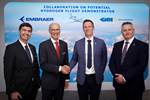Embraer conducts composite structural wing testing for PDNT
New technologies demonstration platform (PDNT), validating innovative processes, methodologies and new materials, exceeded more than 200% of expected progressive load limit.

Embraer PDNT rendering. Source (All Images) | Embraer
(São Paulo, Brazil) has successfully completed the initial structural fatigue tests of the composite wing that will be used in its new technologies demonstration platform (PDNT).
The innovation project is funded by National Development, Scientific and Technological Funding (FNDCT) — under the support of Brazil’s Ministry of Science, Technology and Innovation (MCTI) and Finep — and is focused on R&D of low and medium technology readiness levels (TRL). Alltec, Equatorial, Motora and TecCer are participating as co-executors.
The first phase of this project involves the development of unprecedented processes and methods to support analysis in ground test benches (RIGs). The composite wing’s reference model structure uses novel production techniques and was subjected to progressive loads that exceeded more than 200% of the expected limit.
“We are excited about the evolution of the project, which brings together industry, government and academia for the development of applied research that contributes to the generation of knowledge and people training,” says Cleiton Silva, VP of technology and advanced projects at Embraer. “Technological innovations are fundamental to accelerating the sustainable aviation of the future and strengthening the competitiveness of Brazil’s industry.”
The static loading test was conducted at ACS Aviation, the demonstrator platform supplier and Embraer partner in São José dos Campos, Brazil. The test validated innovative processes, methodologies and new materials. Next steps include manufacturing the flying laboratory’s fuselage and empennage.
Brazilian Institutes of Science and Technology are involved in the research, such as the Technological Institute of Aeronautics (ITA), the Mauá Institute of Technology (IMT), the Institute of Technological Research (IPT) and the School of Engineering of São Carlos, which belongs to the University of São Paulo (USP).
Related Content
-
Proving thermoplastic composites match carbon fiber/epoxy performance in road bikes
CDCQ, LxSim, Addcomp and Argon 18 collaborate to optimize a carbon fiber/PA6 bike seat post, democratizing AFP and demonstrating materials and process for future designs and production.
-
Damage tolerance testing of sandwich composites: The sandwich CAI test
A new ASTM-standardized test method established in 2022 assesses the compression-loaded damage tolerance of sandwich composites.
-
Testing to support composite bolted joint analysis
An overview of ASTM Standard Guide D8509, and its coupon-level mechanical testing of design properties for analyzing composite bolted joints.






